Lean Startup Methodology: Build, Measure, Learn Your Way to Success
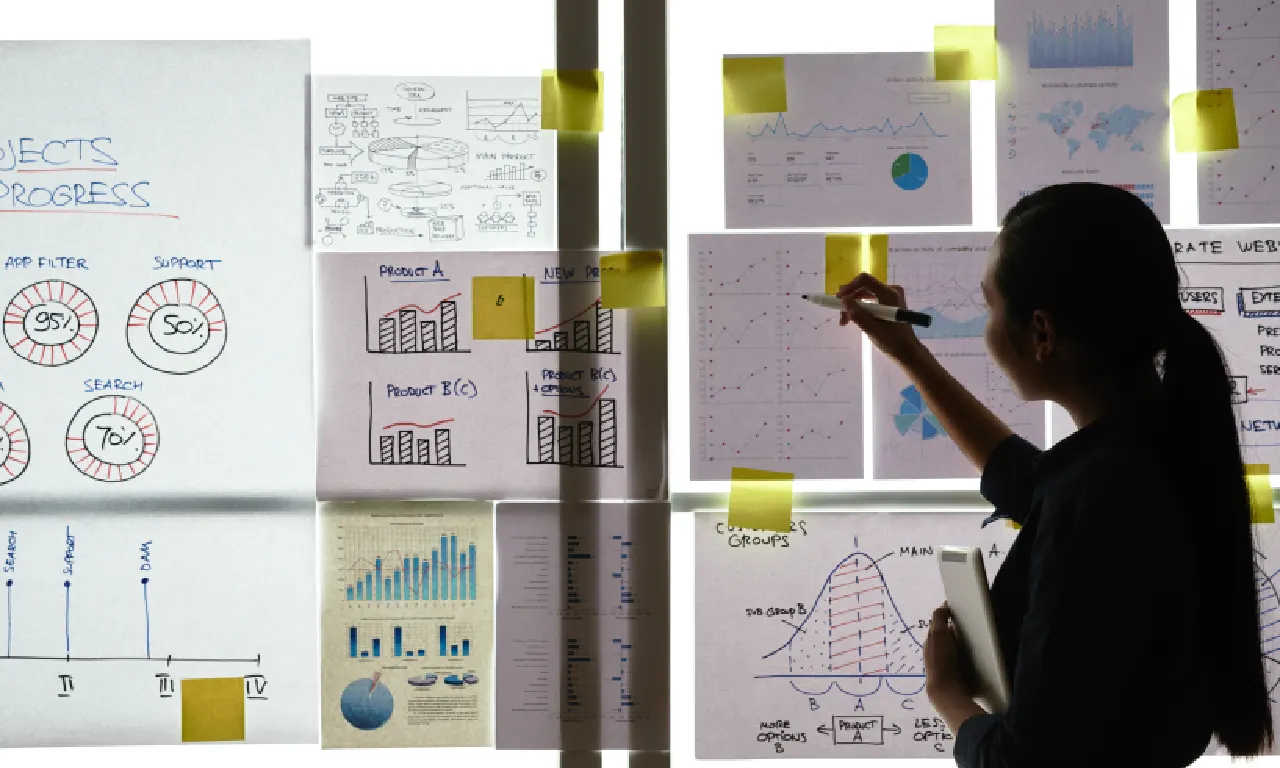
35% of startups fail…
Not because the founders weren't smart or the product wasn't well-built, but because they built something no one actually wanted, and they just found out too late.
So, how do we avoid this? Well, the lean startup methodology comes into play! Instead of pouring months into a polished product and then launching it to crickets, it helps you test your riskiest assumptions fast, using real customer feedback.
What will amaze you is how much this method has achieved. From Airbnb’s first hacked-together listing to data-driven decisions at Fortune 500 giants like General Electric, lean method is now the go-to system for building smart, scalable businesses in any industry.
Let’s break down what it is, why it works, and how you can make it work for you in 2025 with real-world case studies.
What is the lean startup?
You’ve got an idea. You write a full business plan, raise money, hire a team, and spend months perfecting the product. Launch day comes… and barely anyone uses it. Turns out, it was poor product-market fit.
That’s the traditional approach: slow, expensive, and full of guesswork.
Now, imagine a different path. You start small and build a minimum viable product, just enough to test the core value. Ten people try it. Some get stuck, others offer feedback. You fix what doesn’t work and test again. Less waste, lower cost, real progress.
That’s the lean startup approach.
It started with Toyota's lean manufacturing philosophy, evolved through customer development ideas from Steve Blank, and was popularised by Eric Ries in his 2011 book. Since then, the lean startup methodology has become a go-to for anyone building under uncertainty.
It's a shift from building on assumptions to building on evidence. Plus, in a world where attention spans are short and markets move fast, it’s not only smart, it's essential.
The 5 principles that make lean startup methodology work
You’ve probably heard terms like 'MVP', 'pivot', or 'build-measure-learn’ thrown around. However, to really apply the lean startup methodology, you need to understand where these principles fit and why they matter.
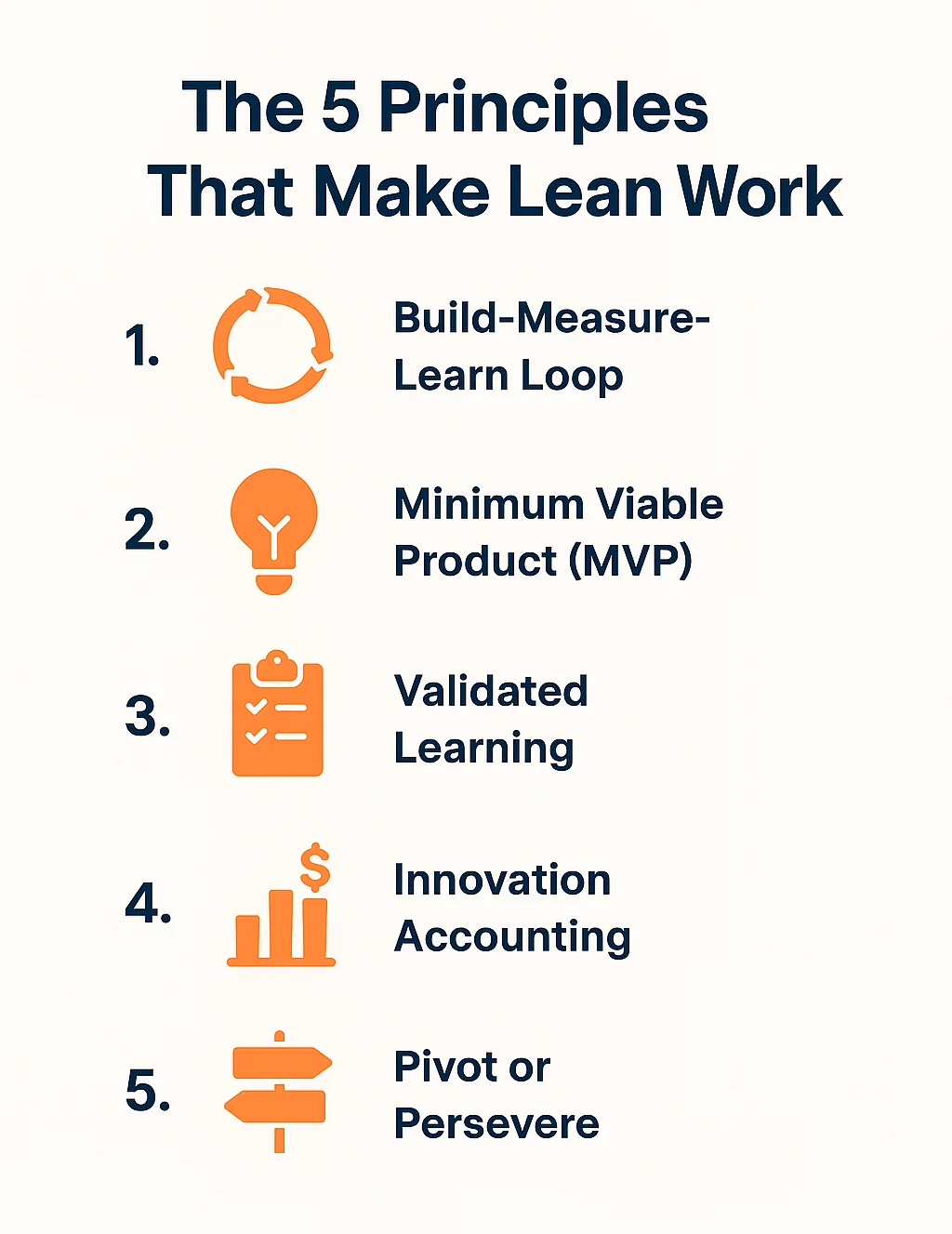
You see, they’re not just jargon. Each one solves a specific problem startups face when building with limited time, money, and clarity. Let’s break them down.
1. Build-Measure-Learn loop
This loop keeps you moving forward when everything feels uncertain. Here, you don't wait for a polished product; rather, you build just enough to test, put it in front of users, and see what sticks.
Then you tweak, repeat, and keep learning. It's how you replace guesswork with insight, and perfectionism with momentum.
2. Minimum viable product (MVP)
An MVP is the simplest version of your idea that people can actually use. The product that you just put out in the previous point? That’s your MVP.
The goal is to see if they care enough to try it, use it, or come back to it. This will help you to learn what clicks and what falls flat before you build too much.
3. Validated learning
Once your MVP is out, your goal now shifts to studying what people actually do. What made them click? Where did they drop off? Did they come back?
This principle is about analysing real user behaviour to learn what’s working, what’s confusing, and what needs to change. It will not only help you learn fast but also let that guide what you build next.
4. Innovation accounting
Most founders fall for vanity metrics such as pageviews, signups, and social shares. They look great on slides, but don’t actually tell you if your product's working.
Innovation accounting means tracking what really matters: retention, referral, and customer lifetime value. Basically, metrics that tell you if you're building something worth scaling.
5. Pivot or persevere
Every few cycles, you have to make the hard call: Is this direction working, and I should keep persevering, or are we stuck?
Do remember that if you realise it’s not working, pivoting doesn’t mean failure, it means discipline. You are simply changing direction based on what you’ve learned. Knowing which one to choose (and when) is what keeps good teams from burning out on bad ideas.
The lean startup methodology roadmap, stage by stage
We’ve got the principles down. But knowing the what isn’t enough. To really make the lean startup methodology work, you need to know when to use what.
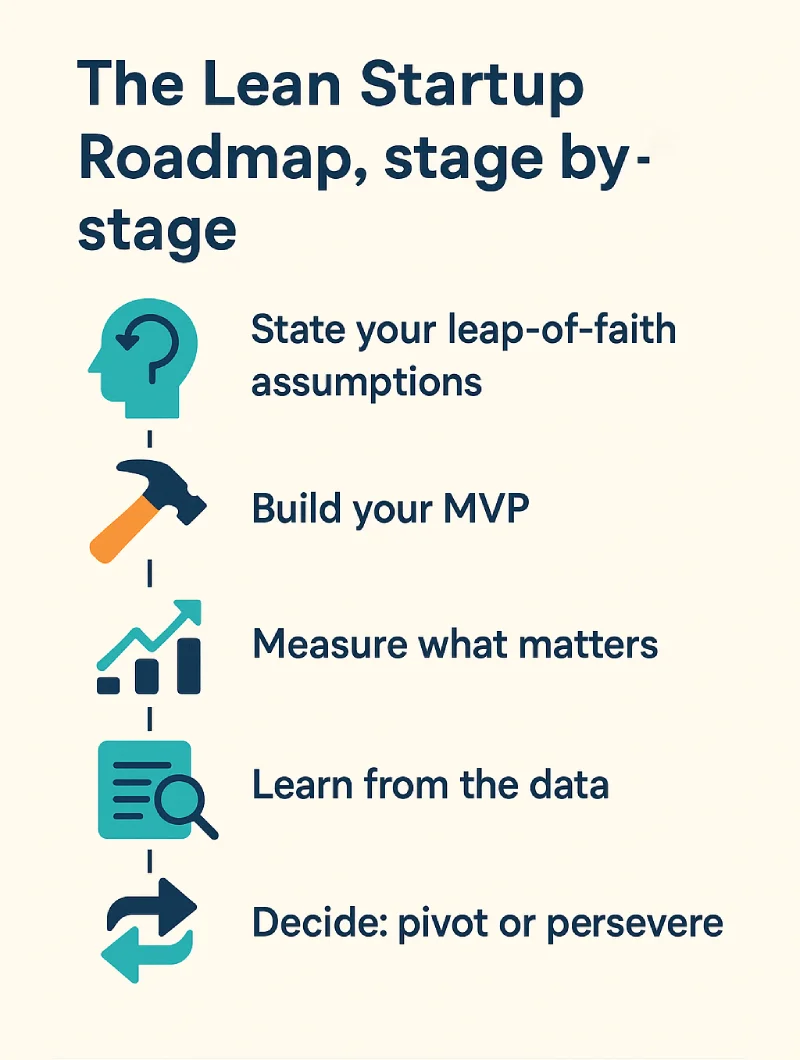
Here’s what that looks like from first sketch to product-market fit:
1. State your leap-of-faith assumptions
Before you start building, nail down what you're really betting on. What’s the core problem you think exists? Who has it? Why would they bother trying your solution at all?
Start with a Lean Canvas. Basically, a one-page sketch of your idea stripped down to the essentials. It’s a tool often used in the lean startup methodology to help founders define assumptions clearly before writing a single line of code. Once you have done that, go talk to potential users.
This is not to pitch but to understand how they're dealing with the problem today. These customer development interviews give you a reality check. If the problem isn’t urgent or your solution doesn’t stand out, this step will give you a direction and set the tone for everything that follows.
2. Build your MVP
Start with one core assumption you want to test, like “People with this problem will sign up if offered this solution,” or “Users are willing to pay for X feature.” Remember, these are hypotheses, not facts. You’re not proving what you know; you're testing what you think you know.
Also, where rapid experimentation comes in: build just enough to try it out, ship fast, and see how users respond.
You could do this by using no-code tools to spin up a landing page, or fake the backend with a Wizard-of-Oz MVP, where users think it’s automated, but you’re manually running it behind the scenes. Or go the concierge MVP route: offer the service personally to a few users to see how they interact with it before sending out the product full on.
The point is to learn fast and cut waste. Instead of pure guessing, you’re testing, adjusting, and moving.
3. Measure what matters
Not all data is useful. What you’re looking for is valuable behavior which are signals that show whether your product is solving a real, painful problem.
-
Did users sign up and actually use the core feature?
-
Did they come back the next day?
-
Did they share it with someone else?
That kind of behavior tells you you’re onto something. It is the foundation of innovation accounting: tracking learning and progress through real user actions, not suface-level metrics like pageviews or likes. It’s also where data-driven decision-making begins.
You can begin with a simple funnel: how many people landed, signed up, used the core feature, and came back? Simple A/B tests can help you see where people drop off or get stuck.
Lastly, keep your metrics lean. One or two signals that tie directly to your product’s core value are enough at this stage. Right now, you’re not building a dashboard empire; you’re merely figuring out if your idea is working.
Start making data-driven decisions with our AI copilot - Intellsys
4. Learn from the data
You’ve got the numbers, now what do they mean? Compare what users said they'd do with what they actually did. Look at cohort trends. Analyse what’s converting and what’s dead weight. This will be your user journey map.
Meaning, if users are signing up but not sticking around, your onboarding may not be clear. Or if they keep using one specific feature but ignore the rest, that’s a signal to cut the clutter and go deeper on what's working. You can also use the Five Whys to look into the cause for this, helping you refine your product further.
Real user behaviour should tell you what to build, what to drop, and what to fix. You have to make sure to keep this map evolving with every test, every cohort, every “this didn’t work” moment. That's how you learn by building, not just by guessing.
5. Decide: Pivot or persevere
Now, you decide if you should persevere with the direction you have chosen, or should you pivot because it might not be working.
A way you can figure this out is by looking at your key metric, the one that reflects real value for users. Maybe it’s repeat usage. Maybe it’s paid conversions. That’s your North-Star metric, and if it’s trending in the right direction, keep going.
But if things are flat, and you've tested, iterated, and adjusted with no real traction, it might be time to pivot. The change might involve targeting a new audience, reworking the main feature, or exploring an entirely different solution.
Every decision should come from evidence, not instinct. Small, intentional changes based on actual behaviour help teams move forward with focus instead of running in circles.
4 real-world examples of the lean startup in action
The lean startup methodology isn't just a framework for early-stage founders figuring things out in a garage. It's been used by real companies across industries to test ideas before going all in.
Here are a few that applied it in seriously effective ways:
-
SleepyHug: Validating D2C mattresses with a three-SKU MVP
Before tooling up factories, SleepyHug interviewed would-be buyers and dissected 300 competitor mattresses to isolate three pain points: heat build-up, back-support complaints, and confusing pricing.
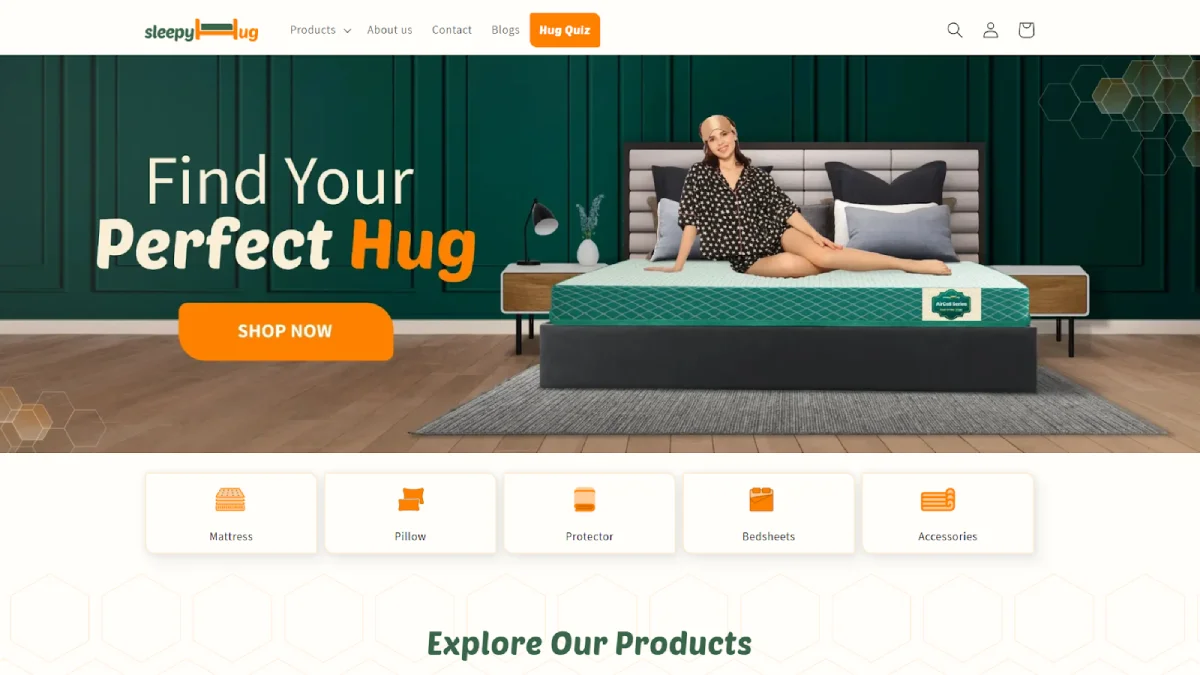
Source[1]
They launched a three-SKU minimum viable product, fulfilled early orders by hand, and measured only hard signals such as repeat usage, returns, and referral rate.
A logistics bottleneck triggered a pivot from 3PL to in-house warehousing, cutting delivery time by 65%. Twelve months later, the same lean principles had scaled SleepyHug to ₹100 crore ARR - all before a Series A round.
Find out how SleepyHug scaled from 0 to ₹100 crore ARR in 18 months
-
Zappos: Selling shoes without inventory
Before building anything complex, Zappos, now a major shoe retailer, tested whether people would even buy shoes online.
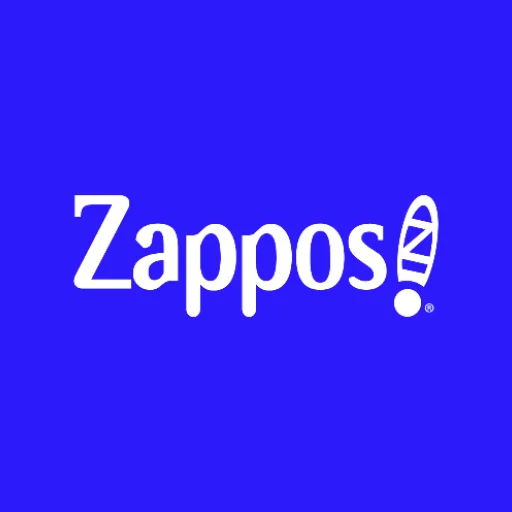
Source[2]
Founder Nick Swinmurn took photos at local stores, listed them online, and bought them manually when orders came in. It worked and validated a market that investors initially thought was impossible.
-
Wealthfront: Earning trust in fintech, manually
Wealthfront, a robo-advisor that automates investing, didn't launch with algorithms and dashboards. The team started by manually helping users manage their portfolios, one by one.

Source[3]
This concierge MVP gave them direct insight into user fears, habits, and expectations; critical learning in a space where trust is everything.
-
Buffer: Testing demand with just a landing page
When Buffer was still just an idea, the team wanted to know if people would actually pay for a tool that scheduled social media posts.

Source[4]
Instead of building the product, they put up a landing page describing the features and added pricing tiers. Anyone who clicked was sent a follow-up email. The responses helped them shape what to build and proved there was demand before they wrote any code.
Common challenges with lean up start methodology (and how to avoid them)
Lean startup sounds simple, but applying it consistently is harder than it looks. These are the traps teams often fall into and how to stay clear of them:
-
Shipping an MVP that’s too rough to be useful: Just because it’s minimal doesn’t mean it should confuse users. Even a scrappy MVP should clearly show what the product is meant to do.
-
Relying too much on user opinions instead of behaviour: Customer Feedback is helpful, but watch what people do, not just what they say. Actions like returning to the product or completing key flows tell you more than any survey.
-
Pivoting too early or too often: Not every slow start is a failure. Look at consumer behaviour trends over time before deciding to change direction. A rushed pivot can derail promising ideas.
-
Treating lean methodology as a one-time experiment: It’s not just for early-stage launches. The Build-Measure-Learn loop works best when it becomes part of how your team works, even after you find traction.
These mistakes are common, but they’re also avoidable. If you catch them early and course-correct, lean stops being a buzzword and actually becomes a useful way to build.
Will the lean startup methodology remain valid in the next 5 years?
Short answer, YES!
The Lean startup methodology is evolving fast, and in 2025, it’s being shaped by smarter tools and bolder teams. One shift? AI-assisted experimentation. Teams are using AI to generate product variations, automate A/B tests, and spot user patterns faster, cutting down weeks of testing to days.
Large enterprises like Microsoft and Unilever have adopted iterative development models internally, launching smaller feature sets quickly and adjusting based on usage and not just long planning cycles. This blend of startup speed and corporate scale is becoming the new normal.
As a Startup accelerator in India for enterprises, we work with Fortune 500 teams to validate ideas, design MVPs, and launch internal ventures with absolute speed.
Using our Intellsys.ai platform, we’ve co-built high-impact businesses, embedding cross-functional teams that move fast, learn fast, and build with purpose.
FAQs on the lean startup methodology
What is lean startup thinking?
Lean startup thinking is about building products through quick experiments, real user feedback, and validated learning, instead of long-term plans and assumptions. It helps teams move faster and reduce waste by focusing only on what truly solves the customer’s problem.
What is the lean startup format?
The lean startup format often refers to tools like the Lean Canvas – a one-page chart that maps out your idea’s key elements: problem, solution, customer segments, and revenue model. It’s a fast way to visualise tradeoffs, spot gaps, and stay focused on your key metrics.
How to run a lean project?
To run a lean project, start by defining your riskiest assumptions. Then build a small minimum viable product based on that, test it with early adopters, and measure beyond just opinions. For example, how many people have clicked on the download link, or how many people have signed up? Use these results to make data-driven decisions, then iterate based on what works.
Is lean startup agile?
Lean startup and agile often go hand-in-hand, but they solve different problems. Agile helps teams build efficiently. Lean startup lets you figure out what to build by testing assumptions (a.k.a. hypothesis testing) before going all in.








